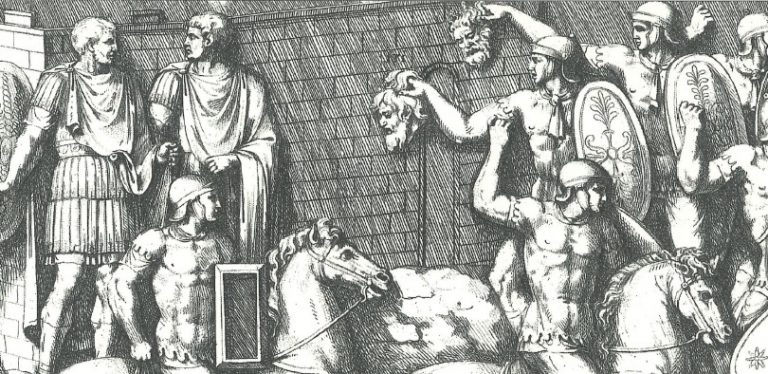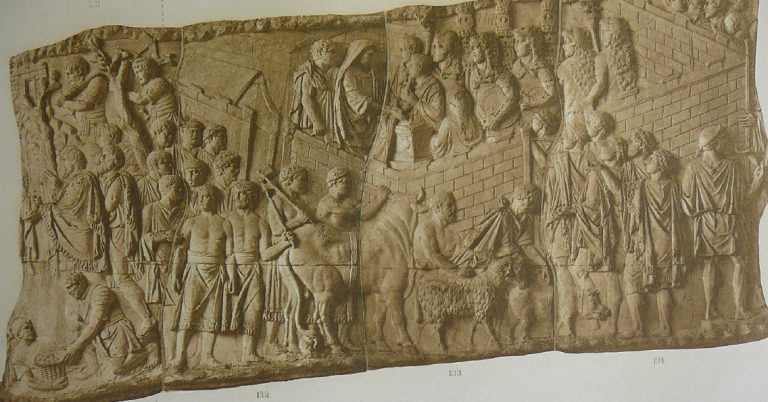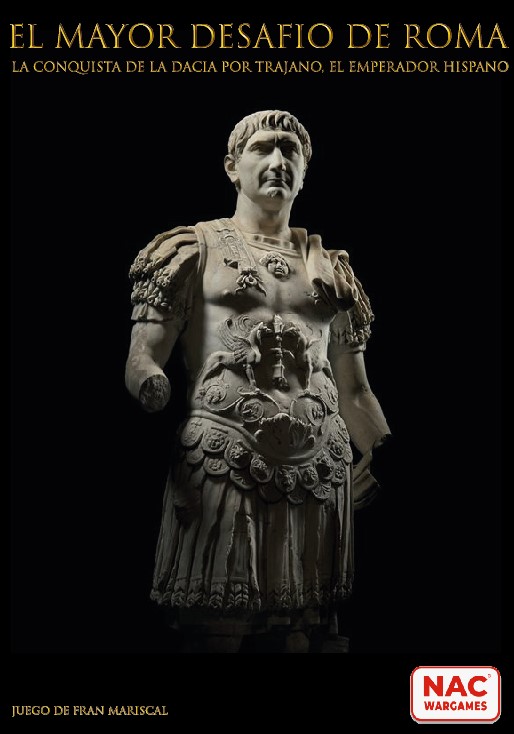
El mayor desafío de Roma, es un juego de guerra operacional con motor de cartas para jugarlo de dos a cuatro jugadores. Con dos jugadores, uno encarnará a Trajano, el Optimus Princeps, dirigiendo a las tropas romanas y aliadas y el otro encarnará la figura de Decébalo, el rey dacio comandando a la entente dácica, formada por dacios, sármatas roxolanos, y los buros, bastarnos, cuados y marcomanos, englobados como pueblos germanos. Las ciudades griegas de Tyras y Olbia están incluidas en el juego como evento de apoyo para el control de los diferentes tramos del rio Danubio, pues el papel de estas dos ciudades como aliadas del reino dacio fue fundamentalmente el de prestar su apoyo naval.
El juego será editado en español e inglés por NAC WARGAMES.
The game will be published in Spanish and English by NAC WARGAMES.
Rome’s Greatest Challenge is a card-driven operational wargame for two to four players. With two players, one will embody Trajan, the Optimus Princeps, leading the Roman and allied troops and the other will embody the figure of Decebalus, the Dacian king commanding the Dacian alliance, made up of Dacians, Roxolan Sarmatians, and the burii, bastarnii , Cuadii and Marcomans, included as Germanic peoples. The Greek cities of Tyras and Olbia are included in the game as a support event for the control of the different sections of the Danube river, since the role of these two cities as allies of the Dacian kingdom was fundamentally to provide their naval support.


Con tres jugadores, uno encarnará a Trajano y su ejército de Mesia Superior, otro comandará los dos ejércitos romanos de Agricola en la Pannonia y Laberio Máximo en Mesia Inferior y el tercero encarnará a Decébalo liderando la entente dácica.
With three players, one will play Trajan and his army from Moesia Superior, another will command the two Roman armies of Agricola in Pannonia and Laberio Maximus in Moesia Inferior and the third will play Decebalus leading the Dacic alliance.
Con cuatro jugadores uno encarnará a Trajano mandando el ejército bajo su mando en Mesia Superior, otro comandará los ejércitos bajo el mando de Laberio Máximo en Mesia Inferior y de Q. Glitio Atilo Agrícola en la Pannonia, el tercer jugador encarnará la figura de Decébalo y el cuarto comandará los ejércitos aliados de la entente dácica.
With four players, one will embody Trajan commanding the army under his command in Upper Moesia, another will command the armies under the command of Laberio Máximo in Inferior Moesia and Q. Glitio Atilo Agrícola in Pannonia, the third player will embody the figure of Decebalus and the fourth will command the allied armies of the dacic alliance
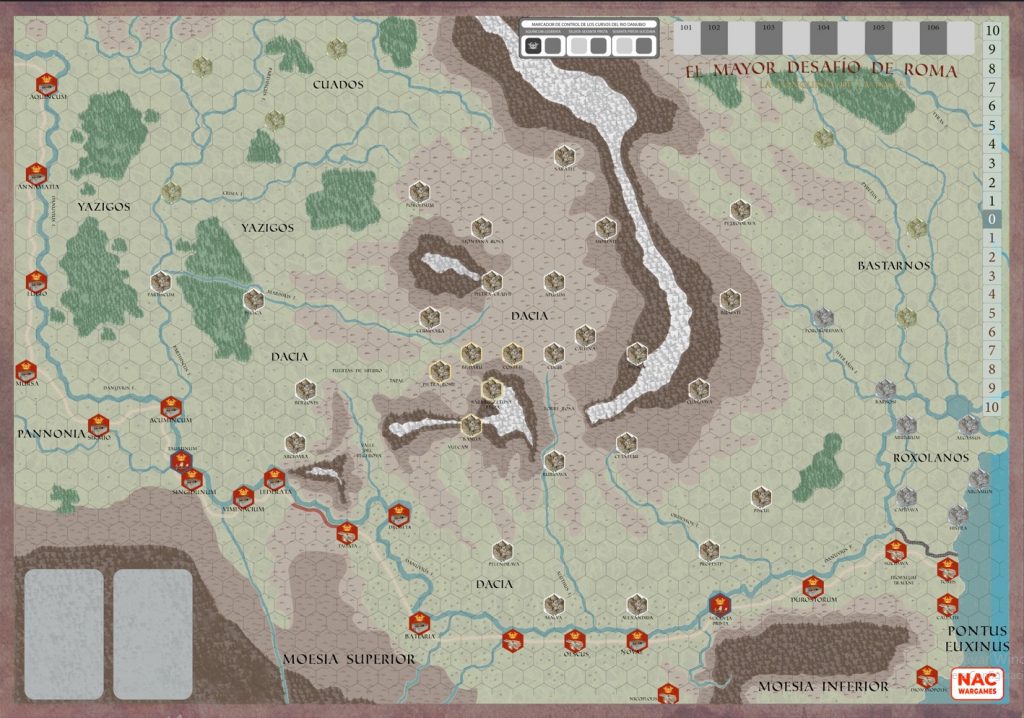
SOBRE EL MAPA DE JUEGO.
ABOUT THE GAME MAP.
El Mapa del juego es un mapa hexagonado, en el que cada hexágono representa unos 25 km cuadrados y que representa el curso del Danubio desde la antigua ciudad de Aquincum, en las afueras de la actual ciudad de Budapest, hasta su desembocadura en el Pontus Euxinus, actual Mar Negro. El mapa recoge parte de las provincias romanas de Pannonia, Moesia Superior y Moesia Inferior al Sur del Danubio y la región de la Dacia y sus territorios limítrofes al norte del rio.
The Game Map is a hexagonal map, in which each hexagon represents about 25 square km and which represents the course of the Danube from the ancient city of Aquincum, on the outskirts of the current city of Budapest, to the Pontus Euxinus. , present-day Black Sea. The map includes part of the Roman provinces of Pannonia, Moesia Superior and Moesia Inferior to the south of the Danube and the region of Dacia and its bordering territories to the north of the river.
SOBRE LOS TURNOS DE JUEGO.
Cada turno de juego se corresponde con una estación y comienza en el Verano del año 101 y termina en el Invierno del año 106.
Los turnos son muy asimétricos con los turnos de verano en los que se juegan 9 cartas y los turnos de invierno en los que tan solo se juegan 3.
Each game turn corresponds to a season and begins in the Summer of the year 101 and ends in the Winter of the year 106.
Turns are very asymmetrical with summer turns playing 9 cards and winter turns playing just 3.
SOBRE LAS FICHAS Y UNIDADES REPRESENTADAS.
ABOUT THE TOKENS AND UNITS REPRESENTED.
Entiéndase que todo el arte que se muestra aquí es provisional y realizado solo a los efectos de elaborar el prototipo del juego para su testeo.
Please understand that all art shown here is provisional and made only for the purpose of prototyping the game for testing.
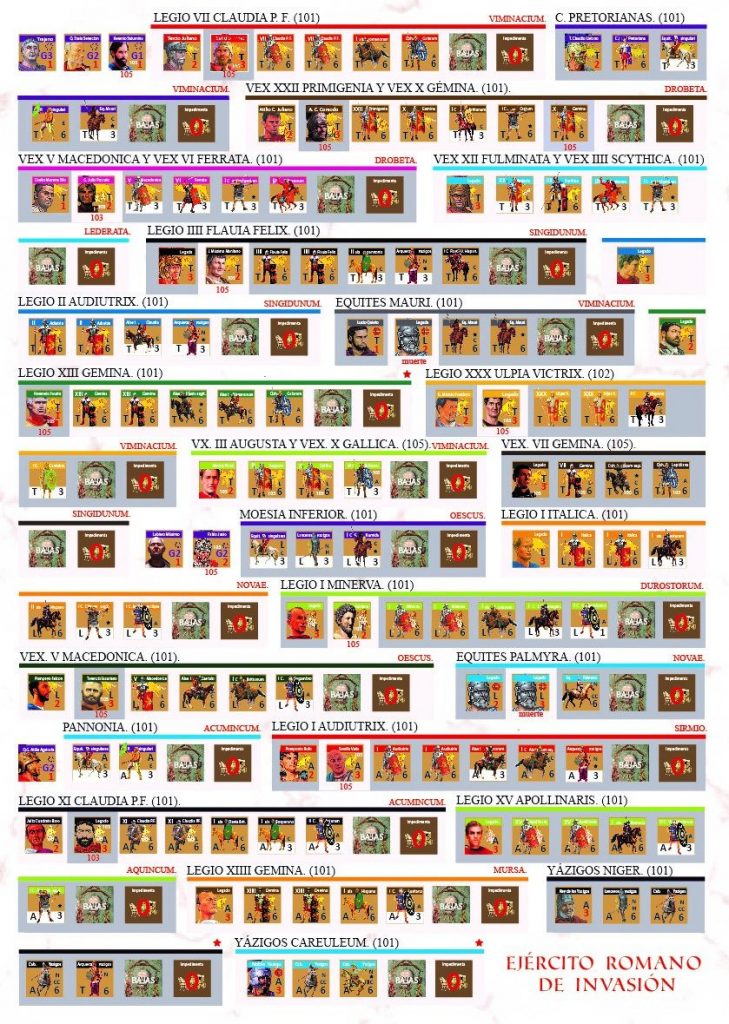
Están representadas las diferentes unidades romanas de las que se tiene noticia que participaron en la campaña, con sus mandos, cuando se conoce el mando, este se ha incluido, cuando no se le conoce, se le atribuye un mando sin nombre solo se le atribuye su papel como legado.
The different Roman units known to have participated in the campaign are represented, with their commands, when the command is known, it has been included, when it is not known, an unnamed command is attributed to it only its role as legatus.
Para encontrar la correlación de fuerzas romanas implicadas ha sido fundamental la consulta de la obra de David Soria Molina: Bellum Dacicum. Geopolítica, estrategia y conflicto en el Danubio bajo Domiciano y Trajano (85-106 d.C.), Madrid-Salamanca, 2016, aunque también he bebido de otras fuentes como Campañas Dacias y Marcomanas. La dinastía Ulpia-Aelia en las fronteras septentrionales de Roma ( 101- 180 D.C. ) de José A. López Fernandez de HRM ediciones, Legiones de Roma, la historia definitiva de todas las legiones imperiales romanas de Stephen Dando-Collins, y otras fuentes que ya compartiré en los diarios de desarrollo.
In order to find the correlation of Roman forces involved, it has been essential to consult the work of David Soria Molina: Bellum Dacicum. Geopolitics, Strategy and Conflict in the Danube under Domitian and Trajan (85-106 AD), Madrid-Salamanca, 2016, although I have also drawn from other sources such as Campañas Dacias and Marcomanas. The Ulpia-Aelia dynasty on the northern borders of Rome (101-180 AD) by José A. López Fernandez de HRM ediciones, Legions of Rome, the definitive history of all Roman imperial legions by Stephen Dando-Collins, and other sources that I will share in the dev diaries.
Sobre las unidades dacias y aliadas, hay menos información, pero se tenía noticia de algunos de sus líderes de su composición general, de su panoplia y su forma de combatir.
About the Dacian and allied units, there is less information, but there was news about some of their leaders, their general composition, their panoply and their way of fighting.
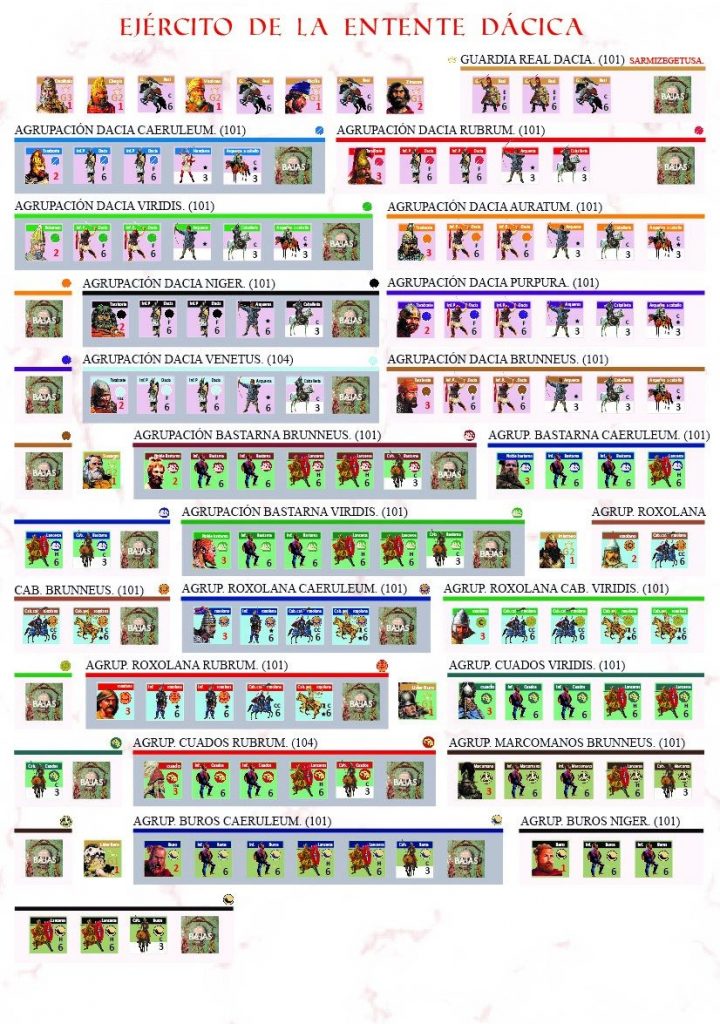
Las unidades romanas están divididas entre las tropas al mando del propio Trajano (portan una T), las tropas al mando de Laberio Máximo (portan una L) y las tropas al mando de Q. Glitio Atilo Agrícola (portan una A). A su vez, estas unidades romanas formadas por legiones, alas de caballería, cohortes auxiliares, y puede que también con tropas aliadas, están reunidas en diferentes agrupaciones al mando de un Legado. Estas agrupaciones están diferenciadas unas de otras por una banda de color en la parte superior de la ficha.
The Roman units are divided between the troops under the command of Trajan himself (wearing a T), the troops under the command of Laberio Máximo (wearing an L) and the troops under the command of Q. Glitio Atilo Agrícola (wearing an A). In turn, these Roman units made up of legions, cavalry wings, auxiliary cohorts, and perhaps allied troops as well, are gathered in different groups under the command of a Legatus. These groups are differentiated from each other by a colored band at the top of the token.
Igual ocurre con las agrupaciones dacias, sármatas y germanas que se distinguen entre ellas por el color de la banda superior.
The same occurs with the Dacian, Sarmatian and German groups that are distinguished from each other by the color of the upper band.
Las fichas representativas de la unidades portan el dibujo de la unidad, el estandarte de la misma cuando es una Legión, un número que representa la cantidad de tropas que conforman la unidad, en el caso de “pedites” o infantería cada 1 representa la cantidad de 1500 hombres de armas, en el caso de caballería cada 1 representa la cifra de 300 jinetes. En la parte superior en la banda de color está reflejado el nombre de la unidad.
The representative cards of the units carry the drawing of the unit, the banner of the same when it is a Legion, a number that represents the number of troops that make up the unit, in the case of «pedites» or infantry each 1 represents the amount of 1500 men-at-arms, in the case of cavalry each 1 represents the figure of 300 horsemen. The name of the unit is reflected in the upper part of the colored band.
SOBRE LOS SUMINISTROS Y LA IMPEDIMENTA DE LAS LEGIONES.
ABOUT THE SUPPLIES OF THE LEGIONS

Cada agrupación empieza el turno con 3 impedimentas, que son los suministros necesarios para alimentar y mantener la agrupación activa durante una estación o turno. Cada vez que una agrupación se activa, gasta una de sus impedimentas, con lo que en principio solo podremos activar 3 veces una misma agrupación en una estación o turno. Mediante eventos, podrá darse el caso de tener más activaciones. Esto representa la dificultad organizativa que tuvo que afrontar el Imperio romano al movilizar a este enorme ejército en campaña, suministrarlo y alimentarlo.
Each legion starts the turn with 3 impedimenta, which are the supplies needed to feed and keep the group active for a season or turn. Every time a group is activated, it spends one of its impedimenta, with which, in principle, we can only activate the same group 3 times in a season or turn. Through events, it may be the case of having more activations. This represents the organizational difficulty the Roman Empire had to face in mobilizing, supplying, and feeding this huge army on the field.
Según defiende Víctor Sánchez Tarradellas, teniente coronel del Cuerpo General del Ejército de Tierra y experto en logística militar —»ese arte sin gloria»—, en su nuevo libro Las legiones en campaña (HRM Ediciones): El ejército romano estaba formado por unos 86.000 hombres que necesitarían diariamente unas 660 toneladas de víveres y 445.000 litros de agua. Unas cantidades desorbitadas y en una misión sobre un territorio arrasado previamente por los defensores de Decébalo. Solo la previsión del emperador y sus oficiales permitió disponer de suficientes recursos para asegurar el éxito de la campaña. En la famosa Columna Trajana, en los foros de Roma, se tallaron numerosas imágenes relacionadas con la logística.
According to Víctor Sánchez Tarradellas, lieutenant colonel of the General Corps of the Army and an expert in military logistics —»that art without glory»—, in his new book Las legiones en campaña (HRM Ediciones): The Roman army was made up of about 86,000 men who would need some 660 tons of food and 445,000 liters of water daily. Exorbitant amounts and in a mission over a territory previously devastated by the defenders of Decebalus. Only the emperor’s foresight and his officials allowed sufficient resources to ensure the success of the campaign. On the famous Trajan’s Column, in the forums of Rome, numerous images related to logistics were carved.
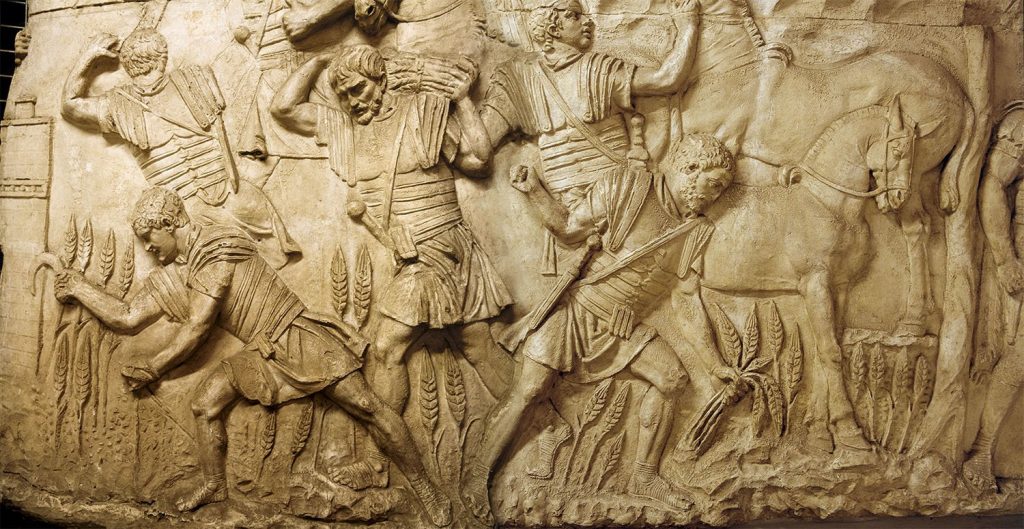
El ejército dacio al estar más cerca de sus bases no tuvo que hacer frente a esta complejidad logística.
The Dacian army, being closer to its bases, did not have to face this logistical complexity.
Los romanos se vieron obligados a jalonar su avance en la Dacia con la construcción de fuertes que aseguraran la ruta de suministros. Y es que al principio de un nuevo turno todas las legiones que sean capaz de establecer una línea de comunicación con un Castrum Legionis y este con otros hasta llegar a las bases de partida se entenderán como suministradas y volverán a recuperar sus impedimenta para gozar de nuevas activaciones durante este turno.
The Romans were forced to mark their advance into Dacia by building forts to secure the supply route. And it is that at the beginning of a new turn, all the legions that are capable of establishing a line of communication with a Castrum Legionis and this one with others until reaching the starting bases will be understood as supplied and will recover their impedimenta to enjoy new activations this turn

Los dacios, en la mayoría de las ocasiones, practicaron una política de tierra quemada, en su retirada hacia los Cárpatos y el corazón de sus reino. Quemaban todo lo que no podían llevarse y pudiera ser útil a los romanos.
The Dacians, in most cases, practiced a scorched earth policy, in their retreat towards the Carpathians and the heart of their kingdom. They burned everything that they could not take and could be useful to the Romans.
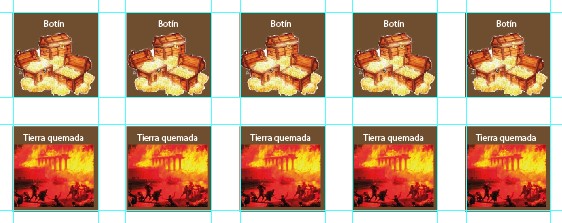
Esto en el juego se representa de la siguiente forma: cuando el ejército romano se acerca a una ciudad o asentamiento dacio, los dacios tienen como opción retirarse y abandonar la ciudad, entonces se hace una tirada de un dado de 6, si el resultado es 4,5 ó 6, el botín que los romanos podrían haber saqueado en la ciudad es destruido y se coloca esta ficha de Tierra quemada, si el resultado es 1,2 ó 3, los dacios no han sido capaces de llevarse o destruir el botín y este queda a merced de los romanos.
This is represented in the game as follows: when the Roman army approaches a Dacian city or settlement, the Dacians have the option of withdrawing and leaving the city, then a die roll of 6 is made, if the result is 4,5 or 6, the loot that the Romans could have looted in the city is destroyed and this Scorched Earth token is placed, if the result is 1,2 or 3, the Dacians have not been able to take or destroy the loot and this is at the mercy of the Romans.
SOBRE LOS ASEDIOS. About the sieges.
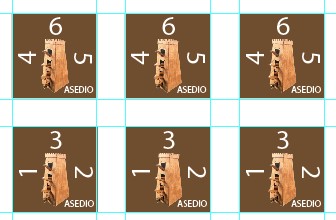

Los romanos solo pueden tomar las ciudades dacias sometiéndolas a asedio o asaltándolas activando la legión o legiones que participan en el asedio, esto se traduce en tiradas en la tabla de asedio que irá que la ciudad o fortaleza vaya perdiendo sus puntos de asedio hasta que caiga finalmente en manos romanas.
The Romans can only take the Dacian cities by subjecting them to siege or assaulting them by activating the legion or legions that participate in the siege, this translates into rolls on the siege table that will cause the city or fortress to lose its siege points until it falls finally in Roman hands.
SOBRE EL MOVIMIENTO DE LAS UNIDADES. ABOUT THE MOVEMENT OF THE UNITS.
Cada legión o agrupación se activa gastando puntos de acción y el coste es el valor de iniciativa del comandante a su cargo. A parte del legado o jefe de agrupación. El jugador tiene la opción de asignar generales o reyes como apoyo a la legión o agrupación. Puede decidir a la hora de activar esa legión o agrupación poner al mando al general o rey asignado, pero como coste no podrá ese general o rey aportar su valor táctico en las batallas.
Each legion or group is activated by spending action points and the cost is the initiative value of the commander in charge. Apart from the legayus or head of the group. The player has the option of assigning generals or kings to support the legion or group. You can decide when activating that legion or group to put the assigned general or king in command, but as a cost that general or king will not be able to contribute his tactical value in battles.
Como habréis observado en las fichas no hay ningún factor de movimiento, esto es porque el movimiento de las fichas campo a través es aleatorio, el factor de movimiento se decide con un dado de seis caras. Los pedites mueven el resultado del dado y los équites el doble del resultado.
As you will have observed in the tokens there is no movement factor, this is because the movement of the cross-country tokens is random, the movement factor is decided with a six-sided die. The pedites move the result of the dice and the equites double the result.
Solo en la calzada romana que recorre todo el sur del Danubio, el movimiento de las fichas romanas es predecible, cómo si hubieran obtenido un resultado de cinco, en su avance por la Dacia la capacidad de movimiento es una incógnita, esto representa las dificultades de los romanos en su avance por un territorio hostil y de orografía compleja. Aunque es de suponer que en las campañas anteriores de Domiciano los romanos realizaran mapas y exploraciones del territorio enemigo. Los dacios mejores conocedores del terreno tienen una bonificación de +1 al resultado del dado. Siendo su máximo movimiento 7.
Only on the Roman road that runs along the entire south of the Danube, the movement of the Roman tokens is predictable, as if they had obtained a result of five, in their advance through Dacia the ability to move is unknown, this represents the difficulties of the Romans in their advance through a hostile territory and complex orography. Although it is to be assumed that in the previous campaigns of Domitian the Romans made maps and explorations of the enemy territory. The more terrain-savvy Dacians have a +1 bonus to the die roll. Being his maximum movement 7.
La potencia que controle un tramo del Danubio puede navegarlo y transportar tropas en el curso que domina.
The power that controls a section of the Danube can navigate it and transport troops on the course it controls.
La construcción de calzadas y vías en la Dacia ocupada y su interpretación en el juego. The construction of roads and tracks in occupied Dacia and its interpretation in the game.
En la columna trajana están representadas escenas del tremendo esfuerzo que a veces los legionarios tuvieron que realizar para preparar caminos para que las legiones y su tren logístico pudieran avanzar en el territorio dacio.
Trajan’s column depicts scenes of the tremendous effort that legionnaires sometimes had to make to prepare roads for the legions and their logistics train to advance into Dacian territory.
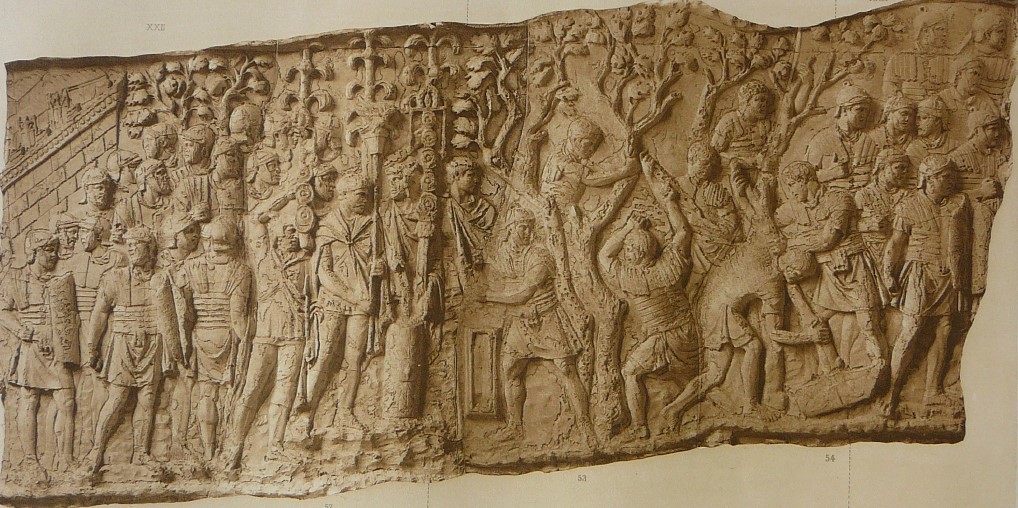
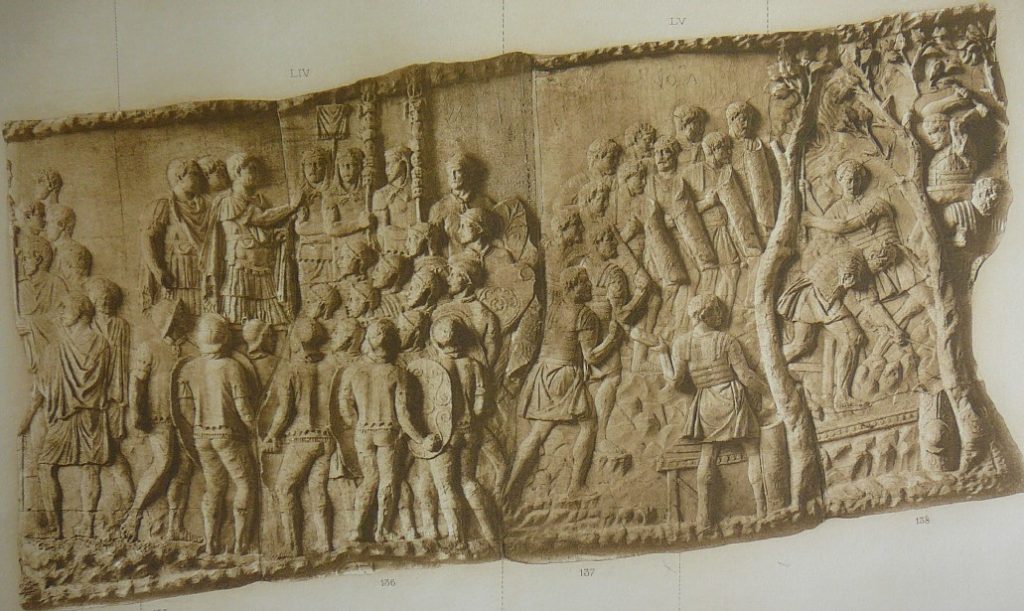
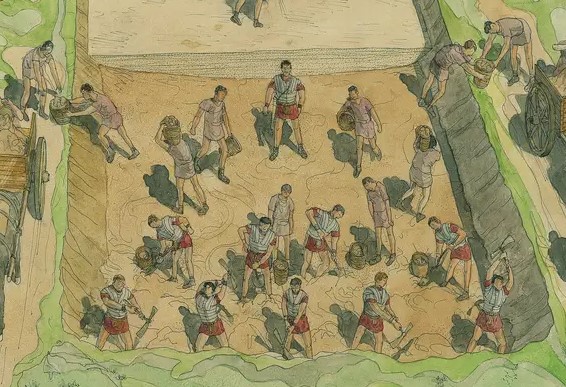
Este trabajo en la elaboración de caminos se refleja en el juego de forma que los romanos, que pueden con sus puntos de acción o eventos ir construyendo «Castrum Legionis» conforme avanzan en la Dacia ocupada, siempre que los Castrum Legionis se encuentren como máximo a 5 hexágonos uno de otro y haya una línea de comunicación abierta en esos cinco hexágonos: al activar una formación el romano la puede mover automáticamente de un Castrum Legionis a otro Castrum Legionis, avanzando automáticamente esos cinco hexágonos y sin que intervenga en esta ocasión el azar en el movimiento. Se entiende que las tropas están discurriendo por caminos preparados por sus predecesores.
This work in the elaboration of roads is reflected in the game so that the Romans, who can with their action points or events build «Castrum Legionis» as they advance in occupied Dacia, provided that the Castrum Legionis are at most within 5 hexagons from one another and there is an open line of communication in those five hexagons: when activating a formation, the Roman can automatically move it from one Castrum Legionis to another Castrum Legionis, automatically advancing those five hexagons and without chance intervening on this occasion on the move. It is understood that the troops are running along paths prepared by their predecessors.
SOBRE LOS COMBATES. About the fighting.



Cuando varias unidades entran en zona de control de otras unidades enemigas se produce una batalla. Varias unidades pueden entrar a la vez en batalla y el defensor puede, con un movimiento de reacción, añadir más unidades próximas a la defensa.
When several units enter the zone of control of other enemy units, a battle occurs. Several units can enter the battle at the same time and the defender can, with a reaction movement, add more units close to the defense.
Las batallas son un mini-juego táctico dentro del juego operacional, que se realizan con cartas de órdenes de combate.
Battles are a tactical mini-game within the operational game, carried out with combat order cards.

Battles occur with both attack and defense combat order cards in four rounds of combat activating the units present in the battle. The army that manages to inflict the most casualties on the enemy army wins the battle.
Antes de iniciarse la batalla, cada comandante, elegirá una táctica de batalla de las cuatro tácticas disponibles. Esta táctica le asegura una determinada orden de ataque o defensa y determinará, una vez resuelto el combate, las consecuencias del mismo para el perdedor, que pueden variar desde una retirada ordenada ( en la que las pérdidas solo se producen en el combate inicial ), a que se produzca una persecución (y haya de nuevo pérdidas en la persecución) o en una retirada desorganizada ( donde las pérdidas serán mayores y además el ejercito quedará desorganizado tras el combate).
Before the battle begins, each commander will choose a battle tactic from the four available tactics. This tactic ensures a certain attack or defense order and, once the combat is resolved, will determine its consequences for the loser, which can vary from an ordered withdrawal (in which losses only occur in the initial combat), to a persecution (and there are again losses in the pursuit) or in a disorganized retreat (where the losses will be greater and also the army will be disorganized after the combat).
Cuando una agrupación ha sufrido la desorganización en un combate, es necesario gastar puntos de acción en reorganizar el ejercito para que pueda combatir en turnos posteriores. Un ejercito desorganizado ante la aproximación del enemigo se retira sin combatir.
When a group has been disrupted in combat, it is necessary to spend action points to reorganize the army so that it can fight in later turns. A disorganized army before the approach of the enemy withdraws without fighting.
SOBRE LAS CARTAS QUE SIRVEN DE MOTOR DEL JUEGO. ABOUT THE CARDS THAT SERVE AS THE ENGINE OF THE GAME.
Se opta por un mazo único de juego, lo que dará mayor rejugabilidad, pues nunca podrás estar seguro de qué cartas te van a llegar, ni cuándo. Por eso he priorizado el mazo único sobre el tener un mazo particular para cada bando.
There is a unique game deck, which will give greater replayability, since you can never be sure which cards will arrive, or when. That is why I have prioritized the unique deck over having a particular deck for each side.
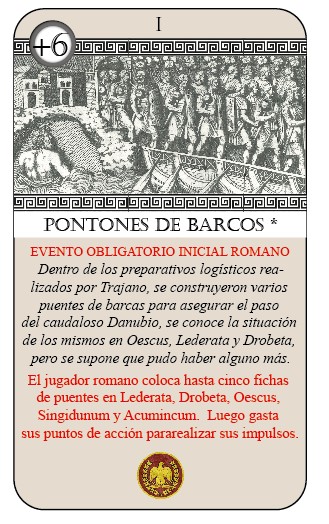
Example of a card with a Roman initial mandatory event, in this card the Roman performs the event and then has his six action points to activate his units, build castrum legionis, organize disorganized troops, etc. (provisional art)
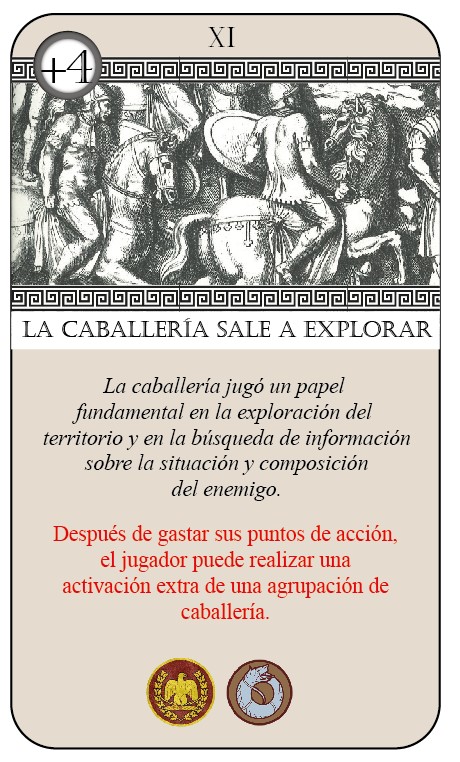

OBJETIVOS DE LOS DOS BANDOS.
El objetivo romano es el de conseguir 10 puntos de victoria y capturar la capital del reino dacio, Sarmiegetusa Regia. La muerte o captura del Rey Decébalo da puntos de victoria. Esto es una carrera contrareloj para el romano que ha de lanzarse decididamente hacia la capital, mientras tiene que ir sumando puntos con el control por asedio del mayor número posible de ciudades dacias.
El objetivo de los dacios es que los romanos no consigan este objetivo y su táctica es eminentemente defensiva, aunque pueden realizar contraataques e invasiones en territorio romano que contrarresten los puntos obtenidos por los romanos y les complique alcanzar el objetivo de 10 puntos de victoria para ganar la guerra.
The Roman objective is to get 10 victory points and capture the capital of the Dacian kingdom, Sarmiegetusa Regia. The death or capture of King Decebalus gives victory points. This is a race against time for the Roman who has to launch decisively towards the capital, while he has to go adding points with the siege control of the greatest possible number of Dacian cities.
The objective of the Dacians is that the Romans do not achieve this objective and their tactic is eminently defensive, although they can carry out counterattacks and invasions in Roman territory that offset the points obtained by the Romans and make it difficult for them to reach the objective of 10 victory points to win. war.
Os seguiré contando más cosas del juego y de la campaña que representa en el diario de desarrollo.
I will keep telling you more about the game and the campaign it represents in the development diary.
Fran Mariscal.

